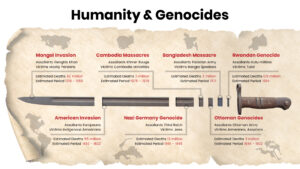Cities are epicentres of human life, innovation, progress and economic development but they are also increasingly at the frontline of turmoil.
Today’s biggest crises are unfolding in cities, from Ukraine’s devastated urban centres to the Gaza Strip, Khartoum in Sudan and Haiti’s capital, Port-au-Prince. Cities are where fragility becomes visible and where conflict, displacement and climate shocks collide, often compounding longstanding inequalities.
These crises are reshaping entire societies and if left unaddressed, they threaten not just local communities but global stability too.
Today, one in four urban residents lives in an informal settlement. Many have been uprooted by war, poverty or climate disasters and most arrive in areas where infrastructure and basic services are overstretched.
The predictable outcomes are human suffering, social tension and weakened economies. But fragility is not inevitable. Cities can become hubs for solutions if investment shifts soon. With seven in 10 people projected to live in urban areas by 2050, addressing urban fragility is a time-sensitive issue.
However, urban crisis response requires three fundamental shifts:
1. Emergency projects to city-led long-term investment
Relief saves lives but stability is built when municipalities can plan, finance and deliver the basics: water, sanitation, energy, safe schools, affordable housing, primary healthcare and climate adaptation that protects people and assets.
It also means expanding opportunities for women and girls, ensuring services are more inclusive and enabling the integration of displaced populations. When this happens, immediate needs are met while local systems and leadership grow stronger.
Cities Alliance’s partnership with Slum Dwellers International, supported by Sida, illustrates this shift. What began as an emergency COVID-19 response evolved into a long-term recovery programme that strengthens urban poor communities and helps them work with local authorities to plan for lasting resilience.
As recent analysis from the OECD underlines, restoring citizens’ trust in institutions through inclusive governance and reliable service delivery is essential to resilience and stability.
2. Fragmented funding to predictable finance
Cities cannot build stability on short-term grants. They need multi-year financing that blends public funds with private capital at a pace communities and local governments can sustain.
The EU’s Global Gateway points in this direction: a connectivity agenda aiming to mobilize up to €300 billion by 2027 through guarantees and blended finance to attract long-term investment in essential infrastructure.
As this model evolves, there are clear opportunities for local governments and civil society to be more closely involved, ensuring investments respond to real urban needs and strengthen local ownership. Turning predictable finance into stability requires pairing financial ambition with inclusive, city-led approaches.
3. Parallel systems to city-led humanitarian-development-peace approach
Mayors and municipalities are often the first responders and long-term stewards, yet are too frequently excluded from national or international decision-making.
When city governments, communities and national authorities co-design priorities, we see fewer duplications, better value for money and faster, more visible results for communities.
Examples show what is possible. In countries such as Sudan, Ethiopia and the Democratic Republic of the Congo, Cities Alliance’s EU-funded SUIDAC programme is working in displacement-hosting cities to improve access to services, create livelihood opportunities and strengthen municipal planning.
This is done by enabling local governments and communities to lead inclusive responses to displacement, engaging residents and displaced people in shaping city plans that build resilience and strengthen local governance, while fostering city-to-city learning exchanges that connect municipalities and partners to share practical solutions.
These are modest steps but they demonstrate how fragile urban areas can move from volatility to predictability when local institutions and communities lead and have the right support.
The role of global finance and the private sector
As investment follows confidence, the private sector will not commit to the long term where services are collapsing, climate risks are unmanaged and institutions are overwhelmed. Private capital needs stability and predictability.
Addressing fragility in cities is, therefore, not only a social imperative; it is also a crucial economic consideration. It is the precondition for investment and growth. There is also a collective-security dividend. Fragile cities can turn a regional shock into a prolonged crisis, driving poverty, displacement, disrupting markets and fuelling instability.
Research from the World Bank shows that fragility rarely remains confined within borders. Instability and violence spill across regions, with over 123 million people forcibly displaced globally by the end of 2024. Such movements strain neighbouring economies and deepen regional fragility, turning local crises into transnational ones.
The reverse is also true.
When urban systems are reinforced, when displaced people are integrated into services and local economies and when communities see tangible improvements, the risks of escalation fall. This is consistent with findings from OECD’s States of Fragility 2025, which links inclusive economies and strong subnational institutions to greater resilience.
In Uganda, a Cities Alliance-supported initiative with Arua municipality and the national statistics bureau led to the inclusion of urban refugees in the 2024 census, ensuring fairer budget transfers and enabling more equitable service planning that fosters social cohesion.
Stability at the city level is a building block of stability at the national and regional levels.
What should change now?
The solution lies in shifting from short-term fixes to systemic investments that empower cities to lead, plan and deliver long-term progress.
These recommendations call on governments, international partners and investors to work with local authorities and communities as equal partners in shaping and financing lasting resilience.
- Back city-led priorities with multi-year finance: Tie funding to measurable service improvements and social outcomes that communities have helped define.
- Blend climate adaptation with essential services: Protect people and critical assets from floods, heat and erosion while expanding access to water, sanitation, transport and energy.
- Invest in livelihoods alongside infrastructure: Skills, opportunities for women and youth, and access to finance reduce incentives for violence and exploitation.
- Institutionalize city voices: Include mayors and municipal teams in national compacts and international forums on crisis response and recovery.
Europe has shown that it can pioneer forward-looking approaches to urban investment. Other donors, including newer actors in development finance, should join. Cities are where the contests for climate readiness, social justice and peace will be decided.
Conflict and fragility are increasingly concentrated in densely populated, fast-urbanising regions, from the Sahel to the Horn of Africa, where urban systems are under growing strain. The costs of inaction are high. The benefits of early, sustained investment are shared by all.
World Habitat Day serves as a reminder that urban crises are indeed global crises. If we want cities to be places of safety, opportunity and dignity, we must move from reactive management to proactive investment. In an urban century, this is not charity. It is a strategy for stability, security and long-term prosperity.
(The article was originally published on World Economic Forum website)








